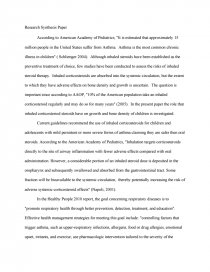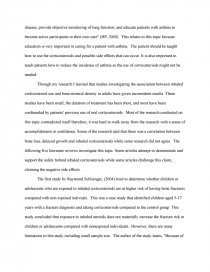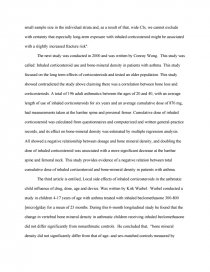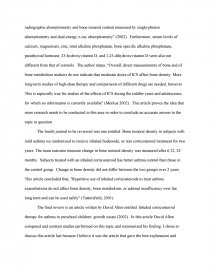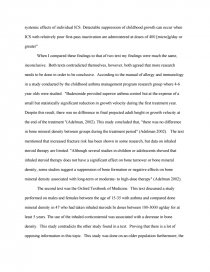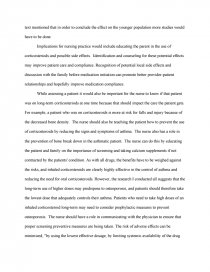Do Inhaled Corticosteroids Have a Long - Term Effect on Growth and Bone Density in Children ?
Essay by review • November 16, 2010 • Research Paper • 2,572 Words (11 Pages) • 2,212 Views
Essay Preview: Do Inhaled Corticosteroids Have a Long - Term Effect on Growth and Bone Density in Children ?
Research Synthesis Paper
According to American Academy of Pediatrics, "It is estimated that approximately 15 million people in the United States suffer from Asthma. Asthma is the most common chronic illness in children" ( Schlienger 2004). Although inhaled steroids have been established as the preventive treatment of choice, few studies have been conducted to assess the risks of inhaled steroid therapy. Inhaled corticosteroids are absorbed into the systemic circulation, but the extent to which they have adverse effects on bone density and growth is uncertain. The question is important since according to AAOP, "10% of the American population take an inhaled corticosteroid regularly and may do so for many years" (2005). In the present paper the role that inhaled corticosteriod steroids have on growth and bone density of children is investigated.
Current guidelines recommend the use of inhaled corticosteroids for children and adolescents with mild persistent or more severe forms of asthma claiming they are safer then oral steroids. According to the American Academy of Pediatrics, "Inhalation targets corticosteroids directly to the site of airway inflammation with fewer adverse effects compared with oral administration. However, a considerable portion of an inhaled steroid dose is deposited in the oropharynx and subsequently swallowed and absorbed from the gastrointestinal tract. Some fraction will be bioavailable to the systemic circulation, thereby potentially increasing the risk of adverse systemic corticosteroid effects" (Napoli, 2001).
In the Healthy People 2010 report, the goal concerning respiratory diseases is to "promote respiratory health through better prevention, detection, treatment, and education". Effective health management strategies for meeting this goal include: "controlling factors that trigger asthma, such as upper-respiratory infections, allergens, food or drug allergies, emotional upset, irritants, and exercise; use pharmacologic intervention tailored to the severity of the disease; provide objective monitoring of lung function; and educate patients with asthma to become active participants in their own care" (HP, 2000). This relates to this topic because education is very important in caring for a patient with asthma. The patient should be taught how to use the corticosteriods and possible side effects that can occur. It is also important to teach patients how to reduce the incidence of asthma so the use of corticosteriods might not be needed.
Through my research I learned that studies investigating the association between inhaled corticosteroid use and bone-mineral density in adults have given inconsistent results. These studies have been small, the duration of treatment has been short, and most have been confounded by patients' previous use of oral corticosteroids. Most of the research conducted on this topic contradicted itself therefore; it was hard to walk away from the research with a sense of accomplishment or confidence. Some of the research said that there was a correlation between bone loss, delayed growth and inhaled corticosteriods while some research did not agree. The following five literature reviews investigate this topic. Some articles attempt to demonstrate and support the safety behind inhaled corticosteriods while some articles challenge this claim, claiming the negative side effects.
The first study by Raymond Schlienger, (2004) tried to determine whether children or adolescents who are exposed to inhaled corticosteriods are at higher risk of having bone fractures compared with non exposed indivuals. This was a case study that identified children aged 5-17 years with a fracture diagnosis and taking corticosteriods compared to the control group. This study concluded that exposure to inhaled steroids does not materially increase the fracture risk in children or adolescents compared with nonexposed individuals. However, there are many limitations to this study including small sample size. The author of the study states, "Because of small sample size in the individual strata and, as a result of that, wide CIs, we cannot exclude with certainty that especially long-term exposure with inhaled corticosteroid might be associated with a slightly increased fracture risk".
The next study was conducted in 2000 and was written by Conroy Wong. This study was called: Inhaled corticosteroid use and bone-mineral density in patients with asthma. This study focused on the long term effects of corticosteriods and tested an older population. This study showed contradicted the study above claiming there was a correlation between bone loss and corticosteriods. A total of 196 adult asthmatics between the ages of 20 and 40, with an average length of use of inhaled corticosteroids for six years and an average cumulative dose of 876 mg, had measurements taken at the lumbar spine and proximal femur. Cumulative dose of inhaled corticosteroid was calculated from questionnaires and computerized and written general-practice records, and its effect on bone-mineral density was estimated by multiple regression analysis. All showed a negative relationship between dosage and bone mineral density, and doubling the dose of inhaled corticosteroid was associated with a more significant decrease at the lumbar spine and femoral neck. This study provides evidence of a negative relation between total cumulative dose of inhaled corticosteroid and bone-mineral density in patients with asthma.
The third article is entilied, Local side effects of inhaled corticosteroids in the asthmatic child influence of drug, dose, age and device. Was written by Kirk Waibel. Waibel conducted a study in children 4-17 years of age with asthma treated with inhaled beclomethasone 300-800 [micro]g/day for a mean of 25 months. During this 6-month longitudinal study he found that the change in vertebral bone mineral density in asthmatic children receiving inhaled beclomethasone did not differ significantly from nonasthmatic controls. He concluded that, "bone mineral density did not significantly differ from that of age- and sex-matched controls measured by radiographic absorptiometry and bone mineral content measured by single-photon absorptiometry and dual-energy x-ray absorptiometry" (2002). Furthermore, serum levels of calcium, magnesium, zinc, total alkaline phosphatase, bone specific alkaline phosphatase, parathyroid hormone, 25-hydroxyvitamin D, and 1,25-dihydroxyvitamin D were also not different from that of controls. The author states, "Overall, direct measurements of bone and of bone metabolism markers do not indicate that moderate doses of ICS affect bone density. More long-term studies of high-dose therapy and comparisons of different drugs are needed, however. This is especially true
...
...
